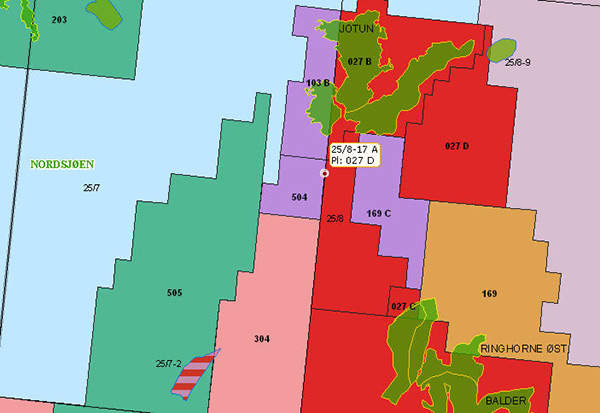Jette (formerly Jetta) field is located in blocks 25/7 and 25/8 of the production licence 027 D in the Norwegian North Sea. The field is one of the smallest in the North Sea. It lies in 127m (417ft) of water, approximately 6km from ExxonMobil’s Jotun field.
Det Norske Oljeselskap is the operator of the field and holds an 88% interest. Petoro holds the remaining 12% interest. Jette is the first field developed by Det norske as an operator.
The project was approved by the Norwegian Petroleum Directorate in February 2012. The development is estimated to cost NKr2.5bn ($439m). First production was achieved on 19 May 2013.. During the first year, the field produced 979,138 barrels of oil equivalent.
The field later witnessed a steady decline in production due to high water cut and its total production amounted to 0.64 million barrels of oil equivalent in 2014.
Although Jette is a small field, its development represents significant benefits for the operator and Norway. Small fields such as Jette can be rapidly put into production using existing infrastructure. It also helps in making maximum utilisation of the infrastructure.
With the development of the Jette field, Det norske can gain insights into the risks and benefits involved in developing comprehensive projects. The project is the first step for Det norske to focus on future developments on the Norwegian Shelf.
Discovery of Jette oil field
Jette was discovered in October 2009 with the drilling of the 25/8-17 well. The well was drilled to a depth of 2,208m and struck oil in the Ty formation. The reservoir thickness was less than expected and a limited amount of oil was discovered.
The 25/8-17A sidetrack well was drilled in November 2009 by the Bredford Dolphin Rig to a depth of 2,154m, to appraise the field. The well penetrated the Heimdal formation.
Geology and reserves of the Jette reservoir
The Jette reservoir lies at a depth of approximately 2,200m in the late Palocene-age Heimdal Formation.
The field is estimated to contain roughly 14 million barrels of oil equivalent. The recoverable oil reserves are estimated at one million cubic metres.
Jette offshore project development
The Jette field was developed through two horizontal wells tied back to the Jotun field. The hydrocarbons produced from the field are mixed with the output from the Jotun field on the Jotun B platform. The mixed output is then sent to Jotun A floating production, storage and offloading (FPSO) vessel for processing and export.
In May 2012, Transocean Barents semi-submersible rig began the first phase of drilling at the field. An observation well was initially drilled at Jette North followed by the production wells, which were drilled between February 2012 and November 2012.
Jotun A FPSO
Jotun A was converted from an AFRAMAX size tanker. It is 223.5m-long and 41.5m-wide with a processing capacity of 145,000 barrels a day. The vessel is installed in 126m of water and is equipped with processing facilities, living quarters and offloading facilities.
Contractors for the Jette field development
Aker Solutions was awarded an NKr60m ($10.5m) contract to supply subsea umbilical for the field. The scope of supply included a 6km-long, electrohydraulic, stainless-steel umbilical, which featured a 3in gas-lift line and performed electrical, hydraulic and methanol injection functions. Aker delivered the umbilical in the third quarter of 2012.
Cameron International agreed to supply the subsea production systems for the field. The $56m contract included the supply of wellheads, trees, controls, pipeline end manifolds and related equipment.
Specialised Management Services was subcontracted by Cameron to manufacture and supply a hydraulic power unit and an umbilical termination unit.
Subsea 7 won a $60m engineering, procurement, fabrication and installation contract. It was responsible for the tie-back of the two production wells. The detailed scope of the contract included the supply of a 6km flexible flowline and jumpers, and the installation of the 6km umbilical Xmas trees, protective structures and other equipment.











